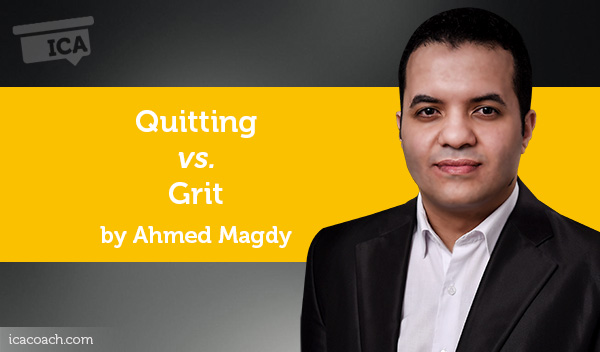
A Coaching Power Tool Created by Ahmed Magdy
(Peak Performance Life Coach, KUWAIT)
What’s Quitting Perspective?
It’s a perspective of losing hope after doing some efforts with nearly minimal results. The dominant feeling in that stage is disappointment accompanied with doubt, the person keeps asking himself: Am I on the right track? What’s wrong with me? Is this thing for me?. So h/she starts to evaluate the whole process, project, dream ..etc based on the current reality of achieving nothing. As he couldn’t see any improvement in the situation so he seriously starts to lose belief, enthusiasm, and commitment. His mood becomes affected negatively, his decision become emotional and lacking determination, and he always expecting the worst to happen.
It’s a sneaky stage as we all heard about the value of being persistent and keep moving forward and pushing until something happens, and all of that stuff, but once the person reach to a level of serious disappointment, he start to think not in terms of losing persistence, but in terms of maybe I need to be persistent In different dream or project, he starts to make it about his abilities and talents not the conditions. Lot of dreamers failed not because they couldn’t dream, but because they couldn’t keep dreaming despite bad conditions and lack of results. We forget that when child learns to walk and falls down 50 times, he never thinks to himself: maybe this isn’t for me?!!
Quitter language is negative, catastrophizing, victimized, Obstacle oriented:
What’s Grit Perspective?
Grit in psychology is a positive, non-cognitive trait based on an individual’s passion for a particular long-term goal or end state, coupled with a powerful motivation to achieve their respective objective. Grit is the tendency to sustain interest in and effort toward very long-term goals. Some personal development literature refer to it as :
G.R.I.T: Guts. Resilience. Initiative. Tenacity
Another interesting observation is that:
G: Give it your all
R: Redo if Necessary
I: Ignore Giving Up
T: Take time to do it right
It’s firmness of character and indomitable spirit. People with Grit keep moving and hustling with acute determination. They have zero doubt toward the probability of reaching their destination. They are absolutely certain and insured that it’s a matter of time and lost trials to manifest their dream into reality.
Their language when challenges come is positive and terrific. For example, they say:
How to move from Quitting toward Grit?
The baseline for our claim is that human being can alter his attitude and change his perspective toward anything. By simply rewiring our neurons in a new synaptic map to create fresh Neuro-pathway of different thoughts and beliefs. Clients need to practice new set of thoughts, beliefs, and attitudes to upgrade their GRIT skills. Here are few action strategies that I use with my clients to help them strengthen their GRIT muscle:
- Do something that scares you every day. Because grit is aobut courage and taking risks. by exercising invading fears, Clients starts to gain more self-confidence.
- Write 5 reasons every day to answer the question: Why you should achieve your dream? Grit is about self-motivation and being connected to your cause on emotional level.
- Writing down goals two times every day to strengthen spirit and to program your mind with your focused goals.
- Focus on making this day the best day possible, don’t look too much in the future and don’t orient your focus on the lack of your goals right now.
How coaching can help in moving clients through the tool?
I usually ask the following question during the coaching conversation to let client explore the other side:
- What if you kept moving forward? What may happen?
- Describe your ideal journey toward your dream.
- Tell me why do follow this project?
- From 0 to 10, how much do you give to your persistence?
- In case it’s less than 10 in previous question, what can we do to reach 10 level persistence ?
- If it’s impossible to fail, what would you do?
Coaching also support client transformation via following up his commitment and designing an action tracks to help him create new habitual patterns thinking and behaving.
Best,
Ahmed Magdy